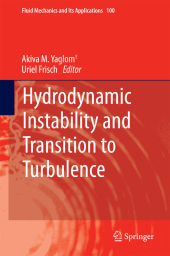 Neuerscheinungen 2015Stand: 2020-02-01 |
Schnellsuche
ISBN/Stichwort/Autor
|
Herderstraße 10
10625 Berlin
Tel.: 030 315 714 16
Fax 030 315 714 14
info@buchspektrum.de |

Uriel Frisch, Akiva M. Yaglom
(Beteiligte)
Hydrodynamic Instability and Transition to Turbulence
Herausgegeben von Frisch, Uriel
2012. 2015. xii, 600 S. 235 mm
Verlag/Jahr: SPRINGER NETHERLANDS; SPRINGER 2015
ISBN: 9400797532 (9400797532)
Neue ISBN: 978-9400797536 (9789400797536)
Preis und Lieferzeit: Bitte klicken
This book examines the considerable advances in recent years in the theory of laminar-flow instability and transition to turbulence. Collects new material on instability to finite-amplitude disturbances, much of which was available only in research papers.
This book is a complete revision of the part of Monin & Yaglom´s famous two-volume work "Statistical Fluid Mechanics: Mechanics of Turbulence" that deals with the theory of laminar-flow instability and transition to turbulence. It includes the considerable advances in the subject that have been made in the last 15 years or so. It is intended as a textbook for advanced graduate courses and as a reference for research students and professional research workers.
The first two Chapters are an introduction to the mathematics, and the experimental results, for the instability of laminar (or inviscid) flows to infinitesimal (in practice "small") disturbances. The third Chapter develops this linear theory in more detail and describes its application to particular problems. Chapters 4 and 5 deal with instability to finite-amplitude disturbances: much of the material has previously been available only in research papers.
Contents.- Foreword by Uriel Frisch.- In Memory of Akiva M. Yaglom: Obituary by Peter Bradshaw.- 1The equations of fluid dynamics and some of their consequences.- 2 Basic experimental facts and introduction to linear stability theory.- 3 More about linear stability theory.- studies of the initial-value problem.- 4 Stability to finite disturbances: energy method and Landau´s equation.- 5 Further weakly-nonlinear approaches to laminar-flow stability: Blasius boundary layer flow as a paradigm.


